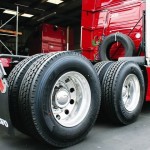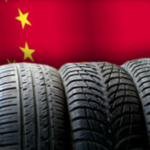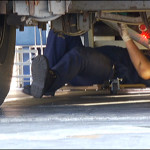
FACTORS TO CONSIDER IN SELECTING THE RIGHT TYRE
- All tyres must be identical in size for the tyres to properly manage the weight of the trailer.
- The combined capacity of the tyres must equal or exceed the Gross Vehicle Weight (GVW) of the axle.
- The combined capacity of all of the tyres should exceed the loaded trailer weight by 20 percent.
- If a tyre fails on a tandem axle trailer, replace both tyres on that side.
- If the tyres are replaced with tyres of a larger diameter, the tongue height may need to be adjusted to maintain proper weight distribution.
INFLATION PRESSURE
Under-inflation is the number one cause of trailer tyre failure. Low inflation pressure elevates tread temperature, especially as speed increases. A tyre can lose up to half of its air pressure and not appear to be flat. Check inflation with a quality tyre gauge. Operation of a trailer tyre that is 30 percent under-inflated can reduce tyre lifespan by approximately 55%. An underinflated tyre creates abnormal tyre flexing and excessive heat causing the following:
- Tyre damage and failure.
- Ride and handling disturbance.
- Reduction of tyre life.
- Decreased fuel efficiency by as much as 10 percent.
Driving on tyres with too much air is also not recommended. Over-inflated tyres are more likely to cut, puncture or fail by sudden impact.
When replacing trailer tyres, always use new valve stems.
REPLACEMENT OF TRAILER TYRES
Trailer tyres can be worn beyond use although they may appear to have adequate tread. This is because trailer tyres support a lot of weight, even when not in use. It is actually better for a tyre to be rolling down the road than to sit in storage, exposed to static weight and UV exposure. During use a tyre releases compound lubricants that are beneficial to tyre life. Using tyres also assists in preventing flat spots from developing.
If one tyre fails, the remaining tyres will be required to suddenly compensate by supporting the increased load. This increase of weight may overload the other tyres causing a chain reaction blowout or other internal structural damage. After a blowout, check the other tyres for damage and replace all tyres on the side of the blowout.
ADOPTING THE BEST PRACTICES
- Any tyre, no matter how well constructed, may fail when in use because of punctures, impact damage, improper inflation, overloading, or other conditions resulting from use, misuse or neglect.
- Every truck or trailer has a maximum speed rating. For example, most ST trailer tyres have a maximum speed rating of 65 mph. High speed towing in hot conditions degrades tyres significantly hence it is better to operate within the speed rating.
- Load carrying capacity decreases as heat and stress generated by higher speed increases.
- Time and the elements weaken a trailer tyre.
- In an ideal environment characterized by good and motorable roads, 3 to 5 years would be the average life expectancy of a trailer tyre regardless of mileage. However, in a dilapidated terrain like we have in most less developed economies, an extensively used truck tyres may not exceed 1-2 years life expectancy.
- It is estimated that in approximately 1 year, roughly one-third of a tyre’s strength is gone.
- After two years, depending upon storage and conditions of usage, consider replacing trailer tyres even if they have tread depth remaining.
- After three years, trailer tyres should be replaced in all cases
REVIEW – PRACTICES FOR SAFE TRAILER TYRE USE
- Select the correct tyres to match the application and capacity requirements.
- Never use passenger car or truck tyres for trailer use.
- Do not overload trailer tyres, maximum loads are listed on the sidewall of the tyre.
- Maintain air pressure at the maximum PSI recommended on the tyre sidewall.
- Check tyre pressure when tyres are cold and in the shade.
- Use a cap on valve stems to prevent contamination of the internal rubber valve.
- Always travel with a spare and check the spare air pressure along with the other tyres.
- Perform a visual inspection of trailer tyres before each trip, inspecting for cuts, bulges, punctures or signs of anything unusual.
- Inspect trailer wheels. If rims are bent or cracked, replacement or repair may be necessary.
- Keep trailer tyres in a cool dry place and out of direct sunlight during storage.
- Use tyre covers to protect tyres from the harsh effects of direct sunlight, moisture and temperature extremes.
- During extended storage, use a thin piece of wood or other surface barrier under tyres to extend tyre life. For seasonal or extreme long term storage, elevate the trailer on blocks to take the weight off the tyres. Reduce the air pressure and cover the tyres to protect them from direct sunlight.
- Replace trailer tyres every two to three years.
- If you experience a series of successive blowouts, something is wrong with your setup, it is not a tyre problem.
Above all, please note that your vehicle was designed with a specific tyre size in mind. For instance, the speedometer is calibrated based on the size of your tyres. Changing to another size ought to be done with the assistance of the OEM or its affiliated tyre replacement centers.






